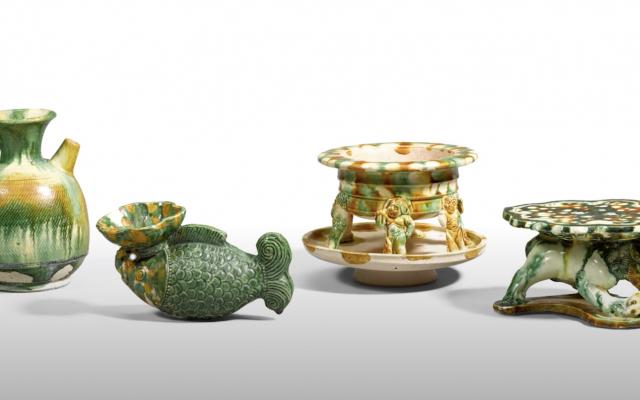What is Tang Sancai or three colour ceramic?
Sancai literally means three colors, but in fact this is a general term because you will see examples of Sancai where there are more than three colors. Usually, these basic colors are green, cream, and amber (called “eggs and spinach” in the West), but the glaze may also have brown, blue, and purple.
During the Tang Dynasty (618-907 AD), Sancai vessels were widely used for burial objects, such as ships and statuettes. Chang said: “On these numbers, you will see that many places are deliberately unglazed.”‘Because the glaze is really flowing, all these different colors will be mixed together during the firing process-this has no effect on facial features. not ideal. Therefore, they kept these features in a polished state, and then painted them with colored paints. In many of the works we see today, the paint is lost because it is mainly composed of organic materials, but the glaze is still vibrant. ’
What is the history of Tang Sancai?
Tang Sancai, also known as three-color colored glaze, is a treasure of ancient Chinese art. It is a kind of hand-made colored glaze vessel with exquisite craftsmanship created in the Southern and Northern Dynasties (386-589) about 1400 years ago. During the Tang Dynasty (618-907), Tang Sancai’s production reached its peak, which is part of the reason for the pottery’s name Tang Sancai.
What is Tang Sancai’s historical background?
According to historical records, during the reign of Emperor Taizong, officials above level 5 in Chang’an were non-Han, accounting for nearly half of the total bureaucracy in the capital. Many Huke caravans traveled to and from Chang’an along the Silk Road. They include Africans, and they were called Kunlun people during the Tang Dynasty. The literature of the Tang Dynasty gave a detailed description of the Hutongs and the Kunlun people, which was further proved by the vivid three-color pottery figures of the period. A group of male pottery figures unearthed in Xi’an, Shaanxi (called Chang’an in the Tang Dynasty) and near Xianyang in the 1950s clearly depict the physical characteristics of Africans. They are the earliest African statues found in China so far. More tricolor statuettes of the Hu nationality have been discovered. They are described as standing, sitting, leading camels, riding horses, playing plucked instruments or dancing. They have deep set eyes, high nose bridges and thick beards, and they are dressed in Tang suits or foreign cultural costumes.
What did Tang San Cai do?
Tang Sancai is a kind of colorful handicraft with yellow, green and white as the main tones. It is fired with lead glaze and presents a harmonious complex of various shades of color. The process is complicated: first, the prepared mold is baked in a kiln until the temperature reaches 1100oC, then it is taken out and glaze is applied. Bake it again at a temperature of about 900°C.
What special dishes does Tang San Cai have?
The objects unearthed by Tang Sancai include horses, people, even pillows and camels, among which camels are one of the best pottery. Its head is raised high, as if telling a story about the Silk Road in the distant past and the prosperous caravans of the Tang Dynasty.
As a treasure of ancient Chinese art, Tang Sancai has absorbed advantages, Buhda, Chinese paintings, sculptures and stone carvings. It is characterized by a fleshy figure, regular and exquisite craftsmanship, compact carving marks and smooth lines, indicating the high level of craftsmanship in the Tang Dynasty. Tang Sancai is mainly divided into pottery tomb figures and daily necessities.
The characters in the tricolor are mostly women. They range in size from ten centimeters to more than one meter, and they wear gorgeous and fashionable clothing, while exuding an atmosphere of elegance and exquisiteness. Their complete figures and round faces meet the beauty standards of the Tang Dynasty. Characters also include depictions of the Hu nationality (a collective term for non-Han people), which makes them a unique feature of the Tang Dynasty.
Why do many Tang San only target horses and camels?
In animal images, horses and camels account for the most. The Tang Empire won on horseback, so the Tang people are particularly in love with horses. No craftsman of any other dynasty can represent horses so vividly. Such works are therefore admired and enthusiastically sought after by people all over the world.
Camels were also an important means of transportation on the Silk Road in the Tang Dynasty 1300 years ago. Many camel statues in the Tang Dynasty are depicted in walking poses, or with their heads high, as if they were grumbling.
What does “three colors” mean?
Tang Sancai (or three-color vessels) is pottery decorated with colored lead glazed surface. “Three colors” means not only three colors, but also multiple colors. Chinese Tang artists are experimenting with a mixture of glazes of various tones. They seem to be fascinated by the colors produced by these mixtures. This three-color glaze technique originated from the monochromatic lead glaze used in the early dynasties.
If there is a technical explanation for the term, it may be that the color is actually
They are based on three different oxides, namely iron is yellow to brown, copper is green or occasionally brown, and rare cobalt is blue. The colors can appear as a single color or together.
The Chinese mainly used these ships for three different purposes. They were used as funerary objects buried in perhaps the tomb of a wealthy businessman, used for sacrifices, and finally used in daily life.


